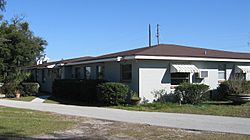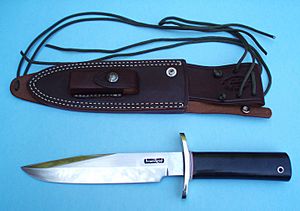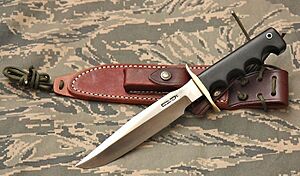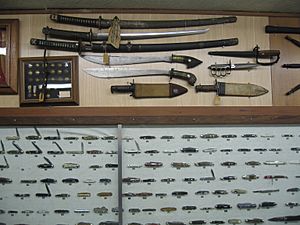Randall Made Knives facts for kids
 |
|
| Private | |
| Industry | Manufacturing |
| Founded | 1938 |
| Founder | Walter Doane "Bo" Randall, Jr. |
| Headquarters | 4857 S. Orange Blossom Trail Orlando, Florida |
|
Key people
|
"Bo" Randall and his son Gary |
| Products | Custom Handmade Knives |
|
Number of employees
|
About 20 |
Randall Made Knives, often called Randall, is an American company. It makes special handmade knives. Walter Doane "Bo" Randall, Jr. started the company in the U.S. Their knife shop and showroom are in Orlando, Florida. Bo Randall began making knives as a hobby in 1937. Today, his son and grandson continue the family business. About 20 skilled workers help them. They make around 8,000 knives each year.
Randall offers 28 different knife models. Each one can be changed to fit what a customer wants. Randall still hand forges almost all their knives. This is different from most companies that use machines. Making a Randall knife takes 17 steps. It usually takes over 8 hours to finish one knife. If you order a knife from the shop, you might wait about six years to get it!
Two special Randall Model 17 "Astro" knives are on display. These knives were made for astronauts. You can see them at the Smithsonian Institution museum. The company also has its own museum. It holds more than 7,000 knives and other sharp tools. It has one of the world's biggest collections of pocketknives.
Contents
History of Randall Knives
Bo Randall first got interested in making knives after seeing a Bill Scagel knife. This knife was used to scrape paint off a boat. It did not show any damage. Bo made his first knife in his garage in Florida. He used an old car spring for the blade.
He officially started his company in 1938. At first, Randall designed knives for people who loved the outdoors. He sold them in sports stores. But demand from soldiers helped his business grow a lot. This made his company famous across the country.
In the early 1940s, Randall knives became very popular. This happened during World War II. Many famous war heroes and soldiers carried Randall knives. These included American Ace Richard Bong and Lieutenant General James M. Gavin. General Gavin led the 82nd Airborne Division during the Normandy invasion. Army Air Force Captain Ronald Reagan, who later became U.S. President, also owned a Randall knife. Soldiers overseas ordered knives by mail. They simply wrote "Knife Man, Orlando" on the envelope.
After the war, more people who were not in the military wanted Randall knives. Randall then made new models for these growing markets. In 1956, Randall got a special U.S. patent for his Model 14 and 15 designs. In 1957, the famous writer James Jones wrote about Randall knives. He mentioned them in his book Some Came Running. He later helped Randall design a knife for divers. During the Vietnam War, General William Westmoreland often had a Randall knife. Pilot Gary Powers and animal expert Ross Allen also carried Randalls. In 1982, Bo Randall was honored. He was put into the Blade Magazine Cutlery Hall of Fame.
Bo Randall passed away in 1989 in Orlando, Florida. He was 80 years old. His son, Gary Randall, now runs the company.
Bo Randall was one of the first people inducted into the Blade magazine Cutlery Hall of Fame in 1983. In 1997, Randall was also added to the American Bladesmith Society Hall of Fame. In 2001, Forbes magazine listed Randall's knives. They called them "Best Sheath Knife" on their "50 Best List."
Randall Knives in Space
When the U.S. started its space program, NASA needed a survival knife for its astronauts. Major Gordon Cooper worked with Randall to design the Model 17 "Astro" knife. The first astronauts carried these Randall knives into space. In 1999, the Liberty Bell 7 space capsule was found in the ocean. Astronaut Gus Grissom's Randall knife was still inside. It had been 15,000 feet underwater for 40 years. But after cleaning, the knife still worked! The Smithsonian Institution has two "Astro" knives on display.
Randall Knives in Music
Texas musician Guy Clark wrote a song called "The Randall Knife." It was a tribute to his father. The song first appeared on Clark's 1983 album Better Days. Vince Gill, who played guitar on Clark's song, also mentions a Randall knife. He does this in his song "The Key to Life." This song is from his 1998 album The Key. Steve Earle, a friend of Guy Clark, mentions a Randall knife in his song "Taneytown." This song is from his 1997 album El Corazon. In 2019, Mr. Earle released a cover of "The Randall Knife." It was on his album Guy, which honored his friend.
Randall Made Knives Museum
The Randall Made Knives Museum is at the shop in Orlando. It has over 7,000 knives and other sharp tools. It holds one of the world's largest collections of pocketknives. It also has the biggest collection of Bill Scagel's knives. The museum shows many old photos and papers about Randall knives. Randall plans to move the museum to a bigger place soon.
Randall Knife Models
Here are some different models of Randall knives. The year they were first made is in parentheses.
Bowie Style Knives
- Model 6 "Steak Knife" (also called "All-Purpose Carving Knife") (1945)
- Model 12 "Bowie" (also called "Smithsonian Bowie") (1953)
- Model 13-12 "Arkansas Toothpick" (1953)
Military Style Knives
- Model 1 "All Purpose Fighting Knife" (1943)
- Model 2 "Fighting Stiletto" (1944)
- Model 14 "Attack" (1954)
- Model 15 "Airman" (1954)
- Model 16 SP#1 "Special #1 Fighter" or "Diver's Knife" (1959) - This knife is made for use near water.
- Model 24 "Guardian" (1979)
Outdoorsmen Knives
- Model 3 "Hunter" (1944)
- Model 4 "Big Game and Skinner" (1945)
- Model 5 "Camp and Trail Knife" (1945)
- Model 7 "Fisherman-Hunter" (1945)
- Model 8 "Trout and Bird Knife" (1946)
- Model 9 "Pro-Thrower" (1947)
- Model 25 "The Trapper" (1988)
- Model 26 "Pathfinder" (1993)
- Model 27 "Trailblazer" (1999)
- Model 28 "Woodsman"
Saltwater Knives
- Model 10 "Salt Fisherman and Household Utility" (1948)
- Model 16 "Diver's Knife" (1959)
Skinning and Hunting Knives
- Model 11 "Alaskan Skinner" (1952)
- Model 19 "Bushmaster" (1963)
- Model 20 "Yukon Skinner" (1963)
- Model 21 "Little Game" (1967)
- Model 22 "Outdoorsman" (1971)
- Model 23 "Gamemaster" (1972)
Survival Knives
- Model 17 "Astro" (1963)
- Model 18 "Attack-Survival" (1963)
See also
 In Spanish: Randall Made Knives para niños
In Spanish: Randall Made Knives para niños




